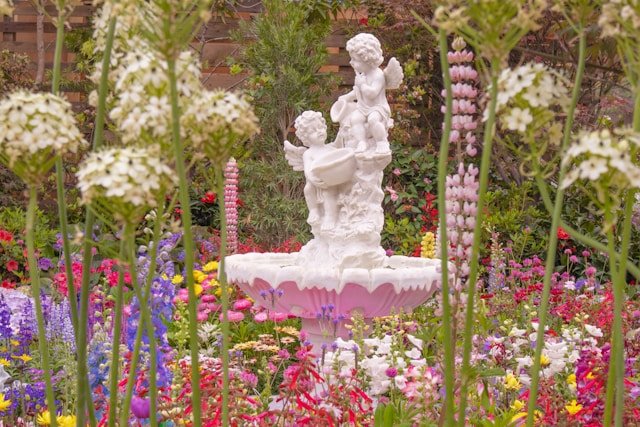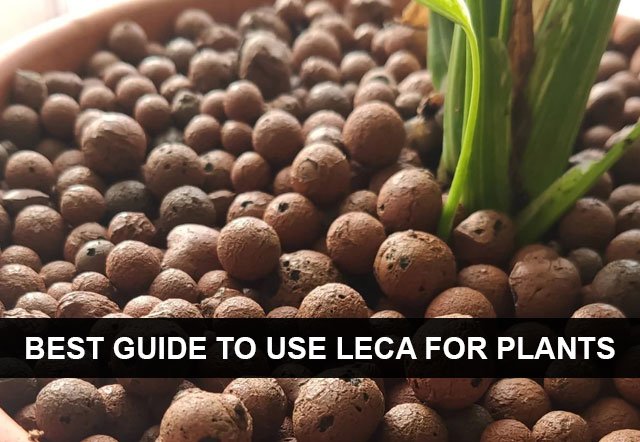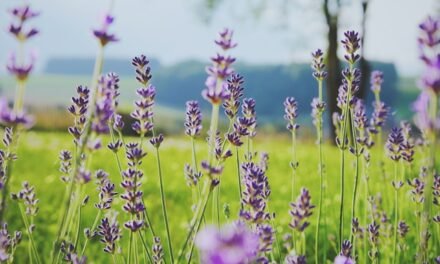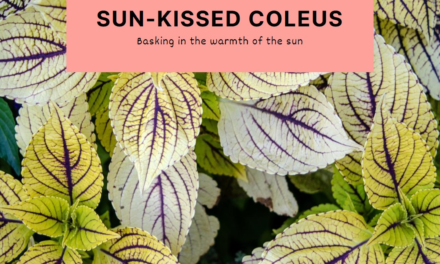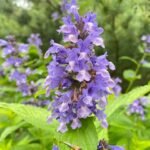When it comes to gardening and landscaping, purple leaf plants are considered beauty invokers of brilliance and beauty. However, these natural wonders are more than just globs of vibrant color that give outdoor spaces a splash of vibrancy. They also have the ability to provide landscapes with a feeling of fascination and hallmark. There is a wide variety of fabulous trees, low plants, and different textures in purple leaf plants. It is very hard to define all of them, individuals even had the freedom to personalize their planting if they desire. Let’s explore the general features of landscape purple leaf plants that make them such prized additions to any outdoor setting:
General Features of Landscape Purple Leaf Plants:
- Vibrant Coloration: Rich purple leaves are showy, possessing a wide range of colors, from dark plum to delicate lavender. They capture every eye by being an attractive central point in flower beds and borders.
- Diverse Species: Purple plant leaves are not exclusive to any particular specie but represent a whole spectrum which includes trees, shrubs, perennials, and annuals to make your garden live and vibrant.
- Architectural Interest: Numerous purple foliage plants display outstanding shapes and line arrangements which combine also to strong visual impact and landscapes’ space balancing.
- Seasonal Variation: The hue of emerald is depending on plant specific and as the season such as autumn is coming down, purple leaves foliage may be turned into shades of bronze, red or gold.
- Wildlife Attraction: The tall bright flowers and beautiful leaves of purple leaf plants are hanging among bird hovering on their way bringing new species into the garden.
- Low Maintenance: Enthusiastic gardeners and especially those who have a full working day will find many purple leafed plants around very adaptive of stress and needing little care which is good news because of their compatibility with great care.
- Adaptability to Various Climates: Purple leaf plants pods in temperate areas due to their multifaceted environmental nature; some can thrive in hot deserts, while others prefer being in milder climates.
- Edible and Medicinal Uses: Certain types of plants with purple foliage, like Lavender and Basil Mint which contain not only ornamental significance but also medicinal and gastric properties, thereby extending the list of their usefulcharacteristics.
- Texture and Contrast: Not only the purple leaves native inherent of coloration, but purple leaf plants also have fascinating textures and differences, where their textures range from glossy and smooth, to the textured matte and satin foliage, and these interesting display adds depth and dimension to garden designs.
- Year-Round Interest: Although some of the purple leaf plants are deciduous and losing leaves in winter, the others are evergreen with their colors and beauty maintaining will give the landscapes continuous beauty and structure all times.
As we begin the trip of our understanding about the different ways the purple leaf plants are gifted in the landscape, let us not forget of the greatness and beauty we are presented with. Majestic or exquisite species are only few adjectives that can describe these stunning plants and they all have the charm and special charisma that attract people and can spice up gardens regardless of their size and style. Hence, let’s take a leap further and visualize the earthbound fantasy of the landscape purple leaf plants in which charm has no limits.
Purple Fountain Grass (‘Pennisetum setaceum’ ‘Rubrum’)
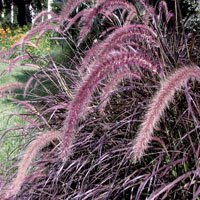
Unlike other ornamental grasses, Purple Fountain Grass, scientifically known as Pennisetum setaceum ‘Rubrum’, is renowned for its vibrant foliage and beautiful slender stems, which gradually form an arching habit. Having Africa as its origin place, it attracts people globally with its beautiful purple-red leaves and feathery plumes which move gracefully according to air speeds. Below are some key features that make Purple Fountain Grass a standout choice for gardeners: Below are some key features that make Purple Fountain Grass a standout choice for gardeners:
Majestic Features of Purple Fountain Grass:
- Striking Foliage: The very rich, deep purple-red foliage of this grass creates real drama in the garden and adds a mature touch to the whole design.
- Graceful Form: The curved nature of the plant makes it seem as if there is a fountain in the garden bed, bringing movement and flow to flower borders and other habitats, enriching the field with dynamic focal points.
- Alluring Plumes: When Purple Fountain Grass enters its second season, it starts to curl leaves in the latter part of summer to early autumn. From there, fluffy bottle brushy plums will start to appear in the colors of burgundy, softened into silver hues, to provide more visual interest and texture.
- Drought Tolerance: This drought-tolerant grass species, fitting for hot and dry conditions, is cherished for its resilience and potential to successfully reproduce even with minimal water once it gets established.
- Versatile Use: No matter if it is planted en-masse for an effect, used as specimen plant, or composed with other plants in mixed containers, the Purple Fountain Grass could be marvelous tool which gives creativity to your landscaping designs.
User-Friendly Features of Purple Fountain Grass:
- Low Maintenance: There is no maintenance required per se on purple fountain grass once it was grown to begin with, so purple fountain grass is the first choice for busy gardeners.
- Easy to Grow: Being a very hardy grass it is fairly easy to grow and can grow under quite diverse conditions of soil type (provided they are well-drained).
- Deer and Pest Resistant: This plant has rough leaves and thus is distasteful to deer. Moreover, the Plant is not popular among the pests that usually destroy gardens.
- Long Season of Interest: The rich purple color of the Purple Fountain Grass lasts throughout the year, and its leaves manage to retain their character, fluffiness, and unique pink/purple hues.
- Container Friendly: With the ability to grow well in containers, Purple Fountain Grass has a vertically slightly accent on patio plantings and mixed collections.
Irritating Features of Purple Fountain Grass:
- Invasive Potential: In particular areas, the Purple Fountain Grass outranks native flora, that it is very successful in crowding out the species.
- Prone to Seed Dispersal: Purple Fountain Grass reproduces by seeds, carried by fluffy seed heads which might uncontrollably disperse the seeds in lawn if not careful.
- Winter Dieback: In cold climates, dieback during winter is possible in Purple Fountain Grass, and probably pruning or protection will be necessary to keep this grass alive throughout winter and expect it to recover in spring.
- Susceptible to Overwatering: Although Purple Fountain Grass is drought tolerant, yet excess watering not only phenomenon the root rot problems but also other water problems in the area as well.
- Maintenance Required: The song ‘Violet Fountain Grass’ is, according to widespread opinion, easy to maintain or maybe this is partly true, but it can be useful to use a brush to remove the dead parts of leaves and spent flower heads.
Conclusion:
To sum up, Pennisetum setaceum ‘Rubrum’ (Purple Fountain Grass) holds an aesthetic place in the garden world, thanks to its really colourful and texturally appealing features that let it be used in various landscape scenarios. Affordability and convenient nature mixed with the easy maintenance the hydrangea is a backyard favorite. To add these qualities to your garden, consider the invasive nature of hydrangeas. Thus, above all, Purple Fountain Grass is a creative idea that incorporates elegance and drama to any outdoor space, for individuals who are willing to stand and face its beauty.
Purple Smoke Bush (Cotinus coggygria)
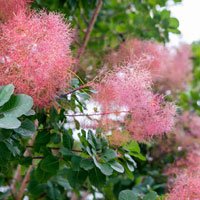
Purple-colored Smoke Bush, the scientific name of which is Cotinus coggygria, is a beautiful deciduous shrub that is recognized for having airy, smoke-like plumes and leaves of a unique color. Having its origin in the south of Europe and Asia, this garden plant is becoming very popular due to its beautiful appearance that is predominantly based on color contrast and texture in landscaping. Below are key features that make Purple Smoke Bush a standout choice for gardeners:
Majestic Features of Purple Smoke Bush:
- Unique Foliage: The foliages of Purple Smoke Bush pop out in an array of deep purple colours, which gradually evolves to a multi-shade rich burgundy colour during the growing season. A spectacular and unique visual effect is created as a background in the garden flower beds and alongside the border.
- Ethereal Inflorescences: While during the months of May and June the shining smoke bush produces light pinkish purple clouds looking like smoke that rises from the garden and creating an intriguing landscape effect.
- Architectural Form: To mention, let’s not forget that its effective structure is the perfect solution for using it as a focal point or as specimen plant in your garden.
- Seasonal Interest: Throughout their blooming season, Purple Smoke Bush features an array of colors, starting from the spring display with its foliage transitioning through various shades of purple and red, finally climaxing with an astonishing summer of purple and red.
- Wildlife Attraction: Aromatic Flowery Nellie becomes the source of nectar for pollinating insects like bees and butterflies and the micro-ecosystem of the garden becomes richer with these pollinators.
User-Friendly Features of Purple Smoke Bush:
- Low Maintenance: In regard to maintenance, the Purple Smoke Bush is satisfactory at only demanding the occasional pruning and fertilization once it is established which is a good thing.
- Drought Tolerance: An exceptional plant for the xeriscaping and water-wise gardens, Purple Smoke Bush is a long-established species which is well adapted for dry conditions and almost drought-tolerant.
- Deer Resistant: Deer and other herbivores would not palatable taste and tough leaves of Purple Smoke Bush as their primary choice of foliage.
- Versatile Use: Based on their aesthetic value, purple smoke bushes are used as specimen shrubs, shrub borders, or as part of the mixed plants. Additionally, they are of great importance for the landscaping patterns designs.
- Tolerant of Various Soil Types: Purple Smoke Bush is soil type tolerant plant that manifests its growth well even in the soils that are sandy, loamy, or clay as long as the soil has been well drained.
Irritating Features of Purple Smoke Bush:
- Potential for Suckering: The Smoke Bush of Purple, being a type that reproduces by sprouting and running its horizontal underground stations, is invasive in some areas.
- Prone to Powdery Mildew: Powdery mildew, a fungal disease that appears first on the foliage and can negatively impact the health of Purple Smoke Bush, whose response to humid environments is known, can affect the plant.
- Slow Growth Rate: Featuring a purple coloration throughout, the Smoke Bush has a rate that is not very fast and, thus, a person is required to be patient to be satisfied with its size and fullness on their landscape.
- Messy Seed Dispersal: The small, dry fruits of Purple Smoke Bush once fallen from the plant will be scattered on streets and gardens. Therefore, the area may get messy, and, for that reason, cleaning will be required on streets and paths.
- Pruning Challenges: Not only is pruning of the Purple Smoke Bush species probably the most challenging task because of their characteristic full, free form and quick generation of young buds from the cut off branches, but it is quite time consuming as well.
Conclusion:
All in all, the purple smoke-bush (Cotinus coggygria) is a shimmering specimen with its daring foliage and unparalleled aura having a perfect architectural form hence among the first ones on the list in the landscaping. The fact that it takes little maintenance and succumbs to some diseases as well as the floating milkweed may be a reason why it is preferred in gardens over polygala by many gardeners; however, this plant is also capable of suckering and is severely affected by the powdery mildew fungus, which some gardeners take into consideration when developing a garden design. Generally speaking, Purple Smoke Bush is like this fairy gift that not only ensures a visual modern delight but also makes guests enjoy its beauty all year round.
Purple-Leaf Sand Cherry (Prunus x cistena)
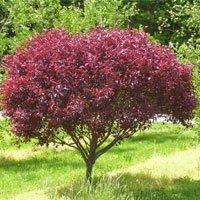
The Purple-Leaf Sand Cherry, a hybrid cherry from the Prunus genus, is a small deciduous shrub that is admired for its beautiful purple-foliage and delicate spring flowers. Starting the offspring from the combination of Prunus cerasifera and Prunus pumila; this ornamental shrub can unleash the beauty and elegance to the flower garden. By owning compact habit and adaptive nature, Purple-Leaf Sand Cherry is a versatile plant at street level for both house gardens and commercial streets. Below are key features that highlight the appeal of this delightful shrub:
Majestic Features of Purple-Leaf Sand Cherry:
- Striking Purple Foliage: Purple-leaf sands cherries are identified by their dark purple foliage that emerges in springtime and keep their captivating color throughout the whole season, creating an amazing scene in gardens, borders or any home feature.
- Fragrant Spring Blossoms: In the early spring, the group of small flowers that emit a gentle floral smell standing in the clusters of pale pink or white color Purple-Leaf Sand Cherry creates are released. This visual and aromatic combination together enriches sensory experience of the garden.
- Edible Fruit: Alongside Purple-Leaf Sand Cherry are different varieties of trees and shrubs, they begin to bloom during May or early summer, and new fruits, from dark purple to black, develop starting from the late summer. These fruits can be used for cooking or eaten raw, and they attract birds, so they have positive impact on wildlife.
- Autumn Color: Autumn leaves of sand cherry transition to colorful burgundy and bronze, finishing with displays of glorious fall colors that truly enhance warm hues and visual diversity of the garden.
- Tolerant of Various Soil Types: Colorado Blue Spruce is very versatile and capable of thriving in different types of soils such as sandy, loamy and clay soils as long they are well drained thus it does well in various garden situations.
User-Friendly Features of Purple-Leaf Sand Cherry:
- Low Maintenance: The Purple-Leaf Sand Cherry only calls for the minimum amount of care once well-established and therefore, it is not only easy to grow this woody plant but also will thrive in your garden bed without extensive prunings or fertilizers.
- Drought Tolerance: Through adaptations, and like other members, this plant is drought tolerant and does not need much of water after it has been established. It can be very useful if you are looking at water-wise landscaping and xeriscaping plants.
- Deer Resistant: When wisely chosen woody plants like Purple-Leaf Sand Cherry offer vegetational benefits that make them less prone to being damaged by deer and other herbivores due to their tough leafage and unpalatable taste.
- Compact Size: This plant fits perfectly to average amount of fertilization and limited framework. The small size of Purple-Leaf Sand Cherry makes it suitable for small gardens, urban gardens, patio planting as well as container gardens.
- Disease Resistance: Purple-Leaf Sand Cherry has a particular characteristic of resistance to normal pests and diseases which lessen the need of chemical sprays and interventions in a garden that may be the outcome of the problem.
Irritating Features of Purple-Leaf Sand Cherry:
- Susceptible to Leaf Spot: In moist settings, piolet could suffer from leaf spot, a fungal disease that might lead to unsightly spots on the leaves and failure to keep them in good condition.
- Short Lifespan: Yellow-Contoured Sand Cherry lives in the smallest circle of life (average of 10-15 years), demanding either replanting or succeeding harvesting in the landscape.
- Messy Fruit Drop: One of the downsides of the little fruit of Purple-Leaf Sand Cherry is that they sometimes drop from the plant every time, thereby requiring that you pick up the pieces lying on the garden area and the walkway.
- Pruning Challenges: This method may be quite difficult beyond just its dense growth habit and the fact that new shoots come up from the bottom of each plant.
- Limited Flowering Period: Meanwhile, the rosy blossoms of Purple-Leaf Sand Cherry are undoubtedly gorgeous and scentful, but the time the flowers take to reach their fullest state is quite little- a month at most, before the doze is over.
Conclusion:
In brief, Plum-Leaf Sand Cherry (Prunus x cistena), a bush with striking purple foliage, fragrant spring flowers and ease of keeping in the landscape is my choice. The low cost, however, natural ecological approach makes cosmos a garden favorite, but those considering using it should be aware though that it is susceptible to leaf spot disease and has a limited lifespan. In fact, Purple-Leaf Sand Cherry is like a little piece of art which adds some elegance to the scenery wherever it is planted. Therefore, it is not surprising that people will constantly be in awe of its beauty throughout the varying seasons.
Purple Heart Vine (Setcreasea pallida)
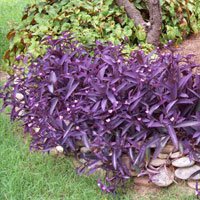
The Purple Heart Vine, a scientific name is Setcreasea pallida, is a purple-leaf plant that grows from the ground and gradually spreads out of bounds. Having been native to Mexico, this cultivar enriches garden and landscape through its ornamental appearance, be it the cascading pattern from hanging baskets, trailing down walls or being used as ground cover. The vine is characterized by its amicable nature and its eye-catching outlook, and hence, it is a favorite for landscape decorators who are trying to apply drama to different outdoor spaces.
Majestic Features of Purple Heart Vine:
- Vibrant Purple Foliage: The most striking trait of Purple Heart Vine is its deep purple leaves that vividly contrast the green foliage around them. This vibrant mix of colors adds intrigue and variation to any planting design.
- Trailing Habit: Purple Heart Vine is well-known for its trailing stems that can form whole beds of beautiful foliage, perfect for hanging baskets and elevated planters.
- Drought Tolerance: The plant thrives most in dry conditions, as it is drought-tolerant after adding it to the garden environment. That makes purple heart vines suitable for water-wise gardening, as well as for xeriscaping.
- Long Blooming Period: The Purple Heart Vine also has colorful foliage followed by small, pink flowers being released all through the growing season and attracting pollinators.
- Easy Propagation: In propagation, Purple Heart Vine can easily be grown from cuttings (stems). Therefore, these cuttings can be multiplied to produce more plants, in this way gardeners can effortlessly fill up empty spaces of their gardens.
User-Friendly Features of Purple Heart Vine:
- Low Maintenance: Purple Heart Vine is an easy-to-care plant that receives minimum watering and occasional pruning to keep its form perfect.
- Fast Growth Rate: With its vibrant growth habit, the lavish leaves of this vine help to fill up garden areas, creating a bloom everywhere they cover, thus making it a great choice for ground cover and controlling erosion.
- Tolerant of Various Soil Types: Although not fussy in terms of soil type, it would prefer sandy, loamy, and clay soils to be well-drained.
- Heat Tolerance: Purple Hear Vine prefers sunny, high-temperature environment and is in the same category as heat-tolerant plants, therefore it can be planted in the sunny spots of the garden.
- Pest and Disease Resistant: Unlike other vines, Purple Heart Vine does not frequently bother with pests and diseases limiting the practice of chemicals on the garden.
Irritating Features of Purple Heart Vine:
- Invasive Potential: In certain areas, like many other invasive species, it tends to be listed as invasive and because of its ability to spread fast and to out compete native vegetation.
- Sensitivity to Cold: Like Violet Crown, true to its name, Purple Heart Vine does not tolerate cold weather and frost, requiring frost protection or shelter for the autumn months and even winter in colder areas.
- Susceptible to Overwatering: Although the Purple heart is highly resistant to drought, it is very prone to developing root rot among other problems because of waterlogging.
- Pruning Challenges: You can prune a purple heart vine, but this is challenging due to dense growth habit with trailing stems, so you will have to start this from scratch to have a controlled physical look.
- Limited Flowering Period: As a type of Purple Heart Vine that blooms pinkish flowers freely all through the season, the blooming period is, nevertheless, too short in contrast with other flowering vines.
Conclusion:
In summary, achieve everlasting appeal and low-maintenance garden wonders using The Purple Heart Vine (Setcreasea Pallida), the vigorous and colorful perennial known for its luxurious foliage, trail habit, and hardiness in the landscape. Its maintenance requirements are low and its growth rate is fast, thus numerous gardeners prefer growing it. Although the plant has invasive qualities and is prone to cold temperatures, it should be incorporated into the garden design with great consideration. In a nutshell, Purple Heart Vine does not just provide just average colors, it gives fanciful and playful touch to the outdoor area, giving the passersby a reason to stay around and bask in its beauty.
Purple Japanese Maple (Acer palmatum)
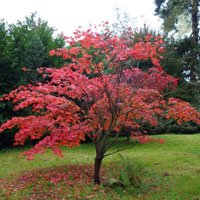
The Purple Japanese Maple, a fascinating ornamental plant, which is scientifically known as Acer palmatum, is appreciated for its dazzling purple foliage and unique form of growth which is highly attractive. From Japanese gardens, Chinese parks, as well Korean layouts, this tree is highly sought after for its sense of harmony and colors. Therefore, it has become a peculiar detail in gardens and landscapes around the globe. The Purple Japanese Maple because of its small size and multipurpose nature being suitable for gardens and also different growing conditions, is one of the most versatile plants to be used in both residential and business areas. Below are key features that highlight the allure of this majestic tree:
Majestic Features of Purple Japanese Maple:
- Striking Purple Foliage: The Purple Japanese Maple stands out from the rest because of its deeply carved leaves that emerge in spring and express their vividness between them until the growing season, this way a stunning landscape feature attracts the attention of the passerby
- Graceful Form: Being the Japanese Maple variety with its cascading and shaggy branches wrapping the foliage in layers, this variety presents an aesthetic silhouette capable of contributing the elegance and the peace needed in garden settings.
- Architectural Interest: The unique pattern of branching and their overall structure of the Autumn Japanese Maple tree provide special architectural interest and therefore become a centerpiece even in the winter when their leaves fell down.
- Autumn Brilliance: As the seasons change, the Purple Japanese Maple leaf turns to hues ranging from crimson red, orange, and gold that, towards the fall, become spectacular autumn-color fans that make the eye wonder.
- Suitable for Containers: With the small and the Japanese maple growth characteristics, it population can be meet their aesthetic in container garden areas, such as patios, the balconies, and urban places.
User-Friendly Features of Purple Japanese Maple:
- Low Maintenance: This Purple Japanese Maple is not demanding much care after establishing. Just quick pruning and fertilization will keep the maple clean and healthy.
- Tolerant of Partial Shade: On the one hand, the cultivar enjoys shade, but on the other hand, it has good adaptability to sunny and partial shade environments. Thus, it met the need to plant under larger trees or in sheltered garden areas.
- Adaptable to Various Soil Types: One reason why Acer palmatum is popular among plant enthusiasts is the ability to grow in almost all soil types including loamy, sandy and clay soils as long as they are well-drained and acidic.
- Deer Resistant: The Purple Japanese Maple’s considerate leaflets and its bitter taste discourage it from being preyed upon by deer and other mammals.
- Longevity: The Purple Japanese Maple, with proper care, can b endure for many years, creating a beautiful setting which will be enjoyed by thousands of people.
Irritating Features of Purple Japanese Maple:
- Sensitive to Sun and Wind: The Cherry Japanese Maple, with weak tissue and delicate foliage, can be destroyed by too bright sunlight or strong gusty wind, and therefore requires shading or care in the placement.
- Slow Growth Rate: The growth speed of Acer palmatum, particularly its youth, is on the slow end of the scale, slowing your joy to attain the desired size and fullness of the plant in the landscape.
- Pruning Challenges: Pruning the Purple Japanese Maple can be a tricky thing as the branches are delicate with a tendency to drip sap so care must be taken to maintain its natural morphology without losing its structural integrity.
- Shallow Root System: Root system of the Purple Japanese Maple is a shallow one which can get dry faster in the hot and dry conditions and hence need frequent water during the drought times.
- Susceptibility to Pests and Diseases: The health of the trees is rather stable, but infestation of aphids, scale insects, and fungal diseases may occur if the trees aren’t properly cared for.
Conclusion:
In summary, I introduce you to Purple Japanese Maple (Acer palmatum), a majestic tree that attracts people with its exquisite shape, beautiful foliage, and versatility in the landscape. Its easy of maintenance and architectural value make it a common choice among gardeners but, its susceptibility to sun and wind, and slowness to mature should be taken into account when putting it in gardens. On the whole, the Purple Japanese Maple touches a trickle of grace and beauty to the outdoor environment, allowing onlookers to appreciate their beauty though entire seasons.
Purple Coral Bells (Heuchera spp.)
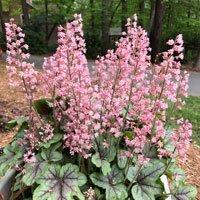
The Purple Coral Bells, Heuchera spp. variety, are undoubtedly the most appealing perennial beauties with the most vibrant purple foliage and cute flowers that create a bell-like shape. They are native to North America and cosmically adaptable as they display a graceful color spectrum in gardens as well as landmarks. Their small size, great versatility, and the functionality they have ratified in landscaping designs make the Purple Coral Bells a great choice for gardeners who wish to bring life and beauty to their garden planting. Below are key features that highlight the charm of these captivating plants:
Majestic Features of Purple Coral Bells:
- Vibrant Purple Foliage: One of the best things about the Purple Coral Bells is their brilliant purple foliage that comes in a variety of shades, from plum-deep to lavender-soft. This brings a wonderful contrast to the garden where they thrive or any containers you may use.
- Graceful Flowers: In Spring to early summer, the ephemeral, bell-shaped flowers of Fontinalis Calendulas appear on fine stems and embellish the garden with their half-term capricious sense.
- Evergreen Qualities: A multitude of Purple Coral Bells varieties are available where green foliage is semi-evergreen or even evergreen throughout the year giving the garden a year-round aspect.
- Versatile Use: Setting apart by its unique touch of purple flowers and colorful foliage, Purple Coral Bells is a great plant for ground cover, edging plants, or accent colors. It can also add depth and dimension to the garden design, just as well as many other plants in mixed plantings.
- Attracts Pollinators: The tubular, nectar-wealthy blossoms of Purple Coral Bells are attractive to insects (bees and butterflies) that by pollination help maintain the rich diversity of the garden ecosystem.
User-Friendly Features of Purple Coral Bells:
- Low Maintenance: Replanting the Purple Coral Bells also has no significant impact on the maintenance, given that they become established they need minimal pruning and deadheading to be in shape.
- Tolerant of Partial Shade: And partial shade they can withstand is their preference, but they can deal well with a variety of light conditions so shade under trees or garden areas would be the ideal spots to plant them.
- Drought Tolerance: There are numerous selections of Coral Bells in purple which are water conserving plants in Shiva style landscaping or in xeriscape gardening.
- Deer Resistant: With the starching foliage that is not edible, the Purple Coral Bells plant roles as a perfect browsing defense from the mastication of deer and other herbivores.
- Pest and Disease Resistant: Lavender Coral Bells prove to hardly succumb to frequent pests and pestilences thereby avoiding the utilization of chemical applications, and face-to-face care in the garden.
Irritating Features of Purple Coral Bells:
- Susceptible to Crown Rot: The system by which water drains away from the roots of Purple Coral Bells, if planted in a soil stirred up with too much water or received excessive watering, can result in rot of the crown which will consequently be destructive to the plant’s overall health.
- Limited Lifespan: Similarly, purple coral bells, although they are considered long-lived perennials they may decline over time and need to be divided and replanted in order to spur growth of the planting.
- Sensitive to Heat: Certain types of Coral Bells pigmented Purple may tolerate very harsh heat. Some may have the same pinkish-brown leaves scorching or wilting because of humidity. This happen especially during summer months.
- Pruning Challenges: Nature – Talk is a slow and dense growth habit with a delicate foliage. Thus, the pruning of Purple Coral Bells is difficult and needs proper care to give them their natural structure.
- Slow Growth Rate: The speed of growing purple coral bells tends to be much slower, especially for the young ones, hence one needs to be patient to get their desired size and lushness in the landscape.
Conclusion:
At the end of the day, the Purple Coral Bells (Heuchera spp.) brings majestic and user-friendly perennials to the garden that have vibrant foliage, graceful flowers, and adaptation. Besides the fact that they are a low maintenance solution that can be grown easily in different conditions, gardeners practicing their cultivation should take into account their tendency to deteriorate when the crown rot disease strikes and have to live with high temperatures. In particular, heights and creamy pink bell-shaped flowers of Purple Coral Bells bring a subtle elegance with color to the outdoor area where they can stay and keep on showing their beauty all the time.
Purple Ninebark (Physocarpus opulifolius ‘Diablo’)
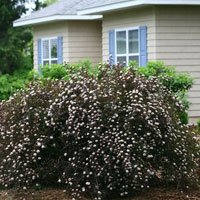
Purple Ninebark is a purple deciduous shrub which grows as a shrub and is often cultivated for its dark purple foliage and its elegance in shape. Scientifically, its name is Physocarpus opulifolius ‘Diablo.’ The seasons are always changing, the leaves fall, and the sparkling landscape of the garden is transformed from a chorus into a lonely note. This Purple Ninebark not only features an attractive color scheme that is suitable for a diverse range of growing conditions, but it is also a very versatile cultivar to incorporate even in residential or commercial spaces. Below are key features that highlight the allure of this stunning shrub:
Majestic Features of Purple Ninebark:
- Deep Purple Foliage: Purple ornamental Plant notably prides itself on its dark purple foliage which is a good contrast and a striking focal point for garden beds and borders.
- Elegant Form: Besides having an expressive silhouette of arching branches cascading downwards, this small plant is of a sweet purple color and can elegantly bring to life a garden landscape.
- Alluring Flowers: The Knowledgeable Ninebark Purple flowers in late spring through early summer, producing clusters of small, pinkish-white flowers that attract pollinators and add to the visual appeal of the beds.
- Seasonal Interest: Through every season, Purple Ninebark changed its foliage from green to bronze and then to red. By the end of autumn there was splendid display of autumn colour that no one could miss.
- Tolerant of Various Growing Conditions: The cultivar will overcome most of the challenges posed by a variety of soil types and lighting conditions, as a result of which planting it will be possible both in the shade and in sun-loving flower beds.
User-Friendly Features of Purple Ninebark:
- Low Maintenance: The vine is quite easy to maintain once it is developed and the process requires may fertilization and pruning to ensure good health and resulting in aesthetic.
- Drought Tolerance: Being very good for dry climate, Purple Ninebark is tolerant of drought once it is established, allowing it to be an option for the plants used for the environment-friendly or xeriscape gardening.
- Deer Resistant: Purple Ninebark is an adaptive plant having dense foliage and foul taste as well. And hence, it is less likely that deer or any other herbivores will attempt to consume it.
- Pest and Disease Resistant: The Blue-Fruited Ninebark varietal is let us say immune to common bugs and illnesses which are detrimental to the garden, therefore, reducing the amount of chemical treatments needed.
- Longevity: With the right attention, Purple Ninebark is as much as a century old, producing beauty and enjoyment across the board, for many years of generations to come.
Irritating Features of Purple Ninebark:
- Susceptible to Powdery Mildew: The Purple Ninebark is prone to powdery mildew in a humid environment, this disease being a fungal disorder that can affect growth and vigor of the plant.
- Pruning Challenges: Shaping Purple Ninebark would not be easy because of it sprouted, sturdy, and are stretching towards the top. This requires special attention so that its natural art befits, and structure is maintained.
- Potential for Suckering: The Purple Ninebark may introduce some competition, as it has the habit of producing runners underground and thereby, can defensively become invasive in an unsuspecting garden.
- Messy Fruit Drop: The very tiny, dry and open fruits of Purple Ninebark can be a bit of a hassle when they drop from the plant and mess up garden areas and walkways, therefore, requiring raking up.
- Slow Growth Rate: Purple Nine bark, it is known for the fact that a lot of time takes for its size to be satisfying for the owner if its growth is slow, especially, when it is young.
Conclusion:
Summing up, Purple Ninebark (Physocarpus opulifolius ‘Diablo’) is indeed a great and reliable choice of shrub as it has dark purple foliage, an aristocratic shape, hardiness, and slower, more manageable growth. Even though its low cares and wide rangе make it a chоiсе of many gardeners, its sensitivity to powdery mildew and sеem ability to sucker lobed should be kept in mind while including it in gardens plans. In particular, the Purple Ninebark brings elegance and vibrancy to backyards and gardens as onlookers will not only discover this lovely plant at specific times throughout the year but be able to appreciate it’s beauty at any point in the future.
Purple Coneflower ( Echinacea purpurea)
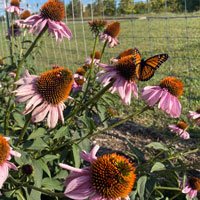
Echinacea purpurea- the common name of this perennial herb is Purple Coneflower. The purple flowers that are produced by this herb are the point of attraction to many and also the Echinacea purpurea infuses many medicinal properties. The fledgling native plant is now exceptionally popular in private gardens and landscapes everywhere. Purple coneflower has become a subject of admiration by every gardener involved in pollinator attraction, and beautifying nature with the lavishing of colors; it is widely cultivated as a favorite due its strikingly beautiful appearance, and because it is easy to raise. Below are key features that highlight the allure of this delightful plant:
Majestic Features of Purple Coneflower:
- Vibrant Purple Flowers: The Purple Coneflower is identified by its unique daisy-shaped blooms with a pronounced cone coconut in the middle, which come in colors of deep purples with orange dots and attract in pollen from bees and small insects.
- Long Blooming Period: Throughout summer and autumn, purple Coneflower continuously pollinate bringing about a continuous display of color and beauty in the garden.
- Medicinal Properties: Not only is it a beautiful flower to decorate home gardens the flowers attract many nonnative insects, and it has been traditionally used because of its immune-boosting capabilities and the relief of cold symptoms.
- Wildlife Attraction: Purple Coneflower flowers exude an essences-rich nectar, thereby making it an indispensable component in the gardening mix. They contribute to the biodiversity of the ecosystem by attracting bountiful beneficial insects and birds.
- Low Maintenance: Since the recommendation for purple coneflower is given once it established, it really does not require a frequent supply of water nor additional fertilizers to survive in the garden scenarios.
User-Friendly Features of Purple Coneflower:
- Easy to Grow: The Echinacea is a pretty easy plant that can be propagated from either seeds or nursery plants, depending on your preference, whether you are a novice gardener or a seasoned enthusiast.
- Drought Tolerance: This is easy and added to the water crisis, its drought tolerant, once settled and hence it can act xeriscaping in waterless gardening.
- Tolerant of Various Soil Types: Echinacea is not very selective of soil, which must be dry a little, so sandy, loamy and clay soils are suitable.
- Deer Resistant: This plant, with its gross vegetation and the disgusting flavour, is scarcely eaten up by deer and other herbivores as they avoid browsing for food, thus preventing them from eating the cones.
- Longevity: Given a fair level of attention from us, Purple Coneflower will grow to stay many years, giving to us their beauty and comfort as seasons change.
Irritating Features of Purple Coneflower:
- Susceptible to Powdery Mildew: In addition, Purple Coneflower might fall victim to powdery mildew, a fungal disease that is spread on the foliage and the general status of the plant.
- Self-Seeding: As a matter of fact, Purple Coneflower is self-sowing and dominating aggressively due to its characteristic, but this also means that it is clearly becoming the invasive weed which might coming out to be an overcrowded neighbor to others in the botanical garden.
- Spent Flowers Require Deadheading: To get a bush with continuous blooming and no self-seeding, the spent flowers in Purple Coneflower should be deadheaded on a regular basis which requires commitment from the gardener as it is quite labor intensive.
- Slow to Establish: The cultivation of the lavender cone flowers might be a little slow in maturing and getting to full bloom in the first few years in the garden, showing some resilience from the grower.
- Limited Color Variations: Purple Coneflower being the most popular among all, colors like pink or white that the plant can assume, pose a problem with the hue dependency.
Conclusion:
Echinacea purpurea is undoubtedly a stupendous and comprehensive perennial herb with glamorous violet flowers, medicinal use, and desired by life of birds and insects. Being easy to manage as regards its low maintenance requirements and ease of cultivation is the decisive factor why many gardeners adore it. At the same time, they should carefully watch its vulnerability to powdery mildew and its self-seeding tendency. Having in mind its overall effect, giving a splash of color and vitality to patios and flowerbeds making them lively and rich with its presence all year round, Purple Coneflower attracts visitors to admire its beauty and absorb its benefits over time.
Purple New Zealand Flax (Phormium tenax)
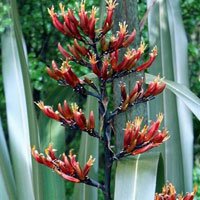
Minted New Zealand Flax, also called Phormium tenax, one of its major common names, depicts a dramatic evergreen perennial that is straightforwardly distinguished for its expressive foliage and sculpted shape. In New Zealand this plant originally was from where it is now grown all around the world and it gives garden designs a wonderful mixed atmosphere and looks. It is a colorful green and blue, fluorescent native plant which is not afraid of some soil types and can grow in various conditions which is why it is widely used in ornamental and practical planting. Below are key features that highlight the allure of this distinctive plant:
Majestic Features of Purple New Zealand flax:
- Bold Foliage: The feature about purple New Zealand own that strikes first is the large, sword-shaped leaves coming out in shades of deep purple that give a contrast in the beds and containers.
- Architectural Form: Its straight, tufted form and tough, leathery leaves let ornamental garden schemes be bolder as they form an essential part of their structural section.
- Year-Round Interest: Purple New Zealand Flax has leaves that are green all year, and its beauty of leathery textures and rich virtually cover the garden landscape even in Winter.
- Tolerant of Coastal Conditions: The plant species, which can be easily adapted to the coastal environment, is undemanding to salt spray and windy conditions, as it may well be planted in seacoast gardens.
- Suitable for Container Plantings: Purple New Zealand Flax would suit well containers of patios and balconies or decks. This plant indeed makes person get more interested, marking the area with a loud statement.
User-Friendly Features of Purple New Zealand flax:
- Low Maintenance: The Purple New Zealand Flax is generally tolerant to excess moisture in a manner that it only needs moderate irrigation and does not require much fertilization to thrive.
- Drought Tolerance: A variety, which is especially suitable for dry areas, Purple New Zealand flax is drought tolerant once taken root; this due to its water efficient nature making it the proper selection for water friendly garden and xeriscaping.
- Deer Resistant: While other species’ leaves are easily chewed by herbivores, the rough and leafy foliage of Purple New Zealand Flax prevents deer and other browsers from feeding upon it.
- Tolerant of Various Soil Types: The variety of Purple New Zealand Flax can grow in a varied assortment of soils such as sandy, loamy, and clay as long as their drainage is not compromised.
- Easy Propagation: As that the Purple New Zealand Flax will multiply with division or seed, the gardeners can obtain those flax in a lot by means of spreading garden space by division.
Irritating Features of Purple New Zealand flax:
- Prone to Leaf Tip Browning: New Zealand Flax with purple flowers may brown the leaf tips, mainly during the hot dry periods or when grown in pots, making it unaesthetically pleasing.
- Susceptible to Frost Damage: Although Purple New Zealand Flax is tough, in extremely cold locations it may freeze and give the pretty leafage a bluish brown colour or collapsed look.
- Invasive Potential: While in some eco-regions it has been proven to be an introduced species, in some others it thrives and can cause serious problems like aggressive growth and take over the native plants.
- Difficult to Remove: The strong root system of purple New Zealand Flax making it difficult to dig out of the ground once its roots are established and it might take gardeners quite a time and labor to cut and pull out the plants since the root system is very stubborn.
- Attracts Pests: Find other flax plants, such as Purple New Zealand Flax, to provide pollinators with suitable forage wherever they are needed. Also avoid certain pests, like aphids and scale insects, which can grow fat by eating up the leaves. This can cause problems for the overall health of the plants.
Conclusion:
To conclude, an outstanding plant with spectacular foliage, beautiful architectural form, and high adaptability in gardens is undoubtedly Purple New Zealand Flax (Phormium tenax). Given that its low maintenance and ability to be grown under different growing conditions, however, the plant is a favorite for many gardeners, the leaf tip browning problem and invasive nature should be managed well. Basically, purple New Zealand Flax gives the outside a sense of drama and greatness that will be appreciated by all visitors as they enjoy and gawp at its beauty and presence all through a year.
Purple Sage (Salvia officinalis ‘Purpurascens’)
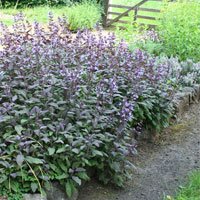
The one with a common name ‘Purple Sage’ or the scientific name itself, Salvia officinalis ‘Purpurascens’ is a fascinating herb due to its scented leaves and the decorative nature. This multipurpose plant is credited to the Mediterranean region, and it contributes more to the herb gardens and landscaping by adding a dash of color and fragrance. Purple Sage exhibits a shiny purple foliage, which makes it a favorite among horticulturists and garden lovers, be it for decorative or utilitarian goals. Below are key features that highlight the allure of this delightful herb:
Majestic Features of Purple Sage:
- Vibrant Purple Foliage: The unique about the Purple Sage that surpasses others in its purple foliage, enhancing the color and contrasts in herb gardens and mixed plantings.
- Aromatic Qualities: In addition to being very fragrant, the sage leaves are the culinary component witch their delectable taste whether used in food, teas or potpourri, purple sage deserves every inch of Johnson’s attention.
- Attractive Flowers: From late spring to mid-summer, Purple Sage blossoms with little flower spikes of light lavender-blue color that make for the about of the plantings and them more vibrant as they are admired by pollinators such as bees and butterflies.
- Drought Tolerance: Equipped with evolved genetics to adjust to drought conditions, Purple Sage is drought tolerant after their first couple of years, thus it will serve you in water-sustainability landscaping and water-wise gardening projects.
- Evergreen Nature: Purple Sage has the ability to maintain purple-like foliage round the year so it can offer beauty and interest in the garden even in winters.
User-Friendly Features of Purple Sage:
- Low Maintenance: If Purple Sage gets well established, this perennial plant only needs small amounts of water & fertilizer to remain healthy and lush at the garden location.
- Deer Resistant: A botanical product with strong smell and bitter taste Original One is greatly protected by grazer animals like deer or other herbivores.
- Tolerant of Various Soil Types: Being a genus that can tolerate many different soil types, Purple Sage can be cultivated in sandy, loamy and clay soils, provided that the soil is well-drained.
- Easy to Propagate: The Purple Sage can be propagated either through stem cuttings of division, thus enabling nature enthusiasts with the opportunity to multiply their plants and fill their gardens with the beautiful purple flowers that their short life span allows.
- Culinary Uses: Cooks value vastly this kind of flavor and color provider, so it becomes a mandatory ingredient of meat, broth, or sauce as a rule.
Irritating Features of Purple Sage:
- Prone to Powdery Mildew: When Purple Sage is grown under such moist conditions e.g. high humidity, it may be susceptible to powdery mildew, a fungal disease that will cause the polyps to be affected and the plant may become unhealthy.
- Susceptible to Root Rot: The Plant Purple Sage may easily be infected by the root rot, if installed in the soil – drainage is insufficient or subject to over-watering. It can be detrimental to the plant and in some cases lead to its death.
- Limited Flowering Period: The flowering sages, although incredibly lovely, are only in blossom for some summer months compared to other flowering herbs that have a more diverse flowering period.
- Woody Growth Habit: As time passes, purple sage may eventually be able to create a mature woody growth that will need periodic rejuvenation pruning to stay lively and maintain the desired shape.
- Attracts Pests: Aphids and spider mites can graze excessive amounts of foliage and eventually harm the plant. Purple Sage may be infested by these pests which is why it is highly recommended that their presence should always be monitored and be acted upon promptly.
Conclusion:
In summary, the frilly fuchsia of the purple sage (‘Salvia officinalis “purpurascens”’) will attract anyone into its beautiful and user-friendly herb. The variegated leaves, their aroma and the fact that it can be used in different ways make purple sage one of the most popular herbs among the public. Low requirements for upkeep and flexibility do give it a good reputation with gardeners but at the same time, the susceptibility for powdery mildew and the lack of flowering period must be monitored. In general, Purple Sage brings a little of color, scent, and taste to herbal gardens and settings but admittedly, in its own way. The onlooker will definitely enjoy its beauty and benefits the entire year-round.
Grand Conclusion:
In summary, purple leaf plants evoke diverse shades of color, weaves, and liveliness that transform mere gardens into outstanding canvas, which play different arts daily. In the vivid purple foliage of the Purple Japanese Maple to the well-formed flowering of the Purple Ninebark, the variety of their hues stimulate the mind and awaken curiosity in those who see them. With their user comfort qualities and colorful variety of species, landscape purple leaf plants show a whole new world of freedom in garden design and aesthetics. Thus, let’s fully take advantage of the magical intricacy of these botanical beauties, as well as embark on a wonderful trip full of charm, beauty, and unlimited opportunities in our own “outdoor home”.

